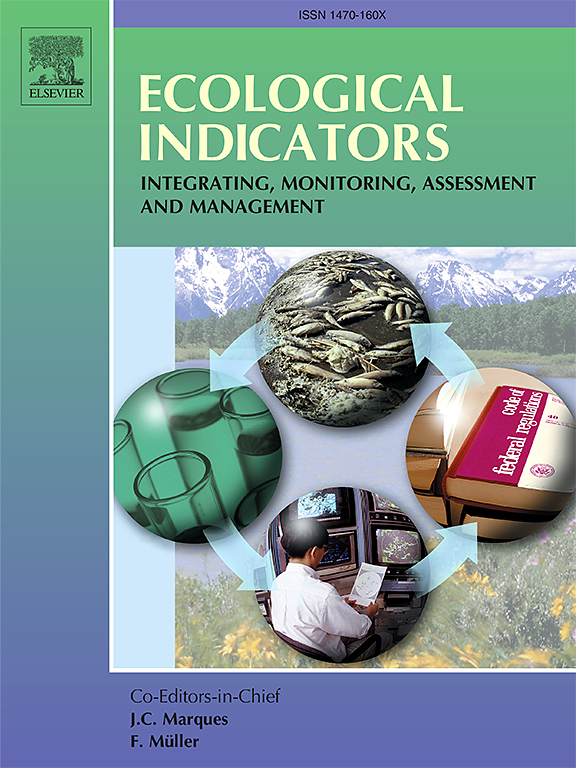低剂量La(III)照射下大豆植物细胞双传感器对植物隐性损伤的指示
IF 7
2区 环境科学与生态学
Q1 ENVIRONMENTAL SCIENCES
引用次数: 0
摘要
稀土元素是一类经常被报道的影响植物生长的新兴污染物。持续暴露于低剂量稀土所造成的危害很少得到研究。快速、准确、无创地监测低剂量稀土对原位植物生长的持续影响是指示和预警其对植物和生态系统危害的关键。在本研究中,连续暴露于低剂量镧[La(III), a REE] 14天后,大豆叶片细胞发生了不可见的损伤,La在大豆叶片中不断积累。茎比;根比;豆荚祝辞种子),造成潜在的人类健康风险。选择叶片细胞中结合La(III)的两种蛋白(vitronectin-样蛋白(VN)和阿拉伯半乳聚糖蛋白(AGP))作为生物标志物,在低剂量La(III)持续暴露14天后,通过构建双传感器在活叶细胞中检测这两种蛋白的变化。结果表明,叶片细胞的电化学输出电子传递电阻Ret(VN)和Ret(AGP)与MDA、叶绿素含量、电解质泄漏、细胞活力、叶片鲜重和干重、叶面积等损伤指标有关。利用该输出,得到了两个可见损伤预警区间:Ret(VN)为8.53% - 47.22%,Ret(AGP)为12.75% - 51.31%。本研究成功实现了低剂量La(III)照射下植物细胞生物标志物变化和不可见损伤的实时原位检测,为低剂量连续暴露稀土对植物损伤的预警监测提供了方法。本文章由计算机程序翻译,如有差异,请以英文原文为准。

The indication of double-sensors in living plant cells on the invisible damage of soybean plants under low-dose La(III) exposure
Rare earth elements (REEs) are a type of frequently reported emerging pollutant that affects plant growth. The harm caused by continuous exposure to low-dose REEs has rarely been studied. Quickly, accurately, and non-invasively monitoring the continuous influence of low-dose REEs on plant growth in situ is key to indicating and warning of its harm to plants and ecosystems. In this study, after continuous exposure to low-dose lanthanum [La(III), a REE] for 14 days, invisible damage occurred in leaf cells, and La accumulated continuously in the soybean plants (leaves > stems > roots > pods > seeds), causing potential human health risks. Two proteins [vitronectin-like protein (VN) and arabinogalactan proteins (AGP)] in leaf cells that bound La(III) were selected as biomarkers, and changes in these two proteins were detected by constructing dual-sensors in living leaf cells after continuous exposure to low-dose La(III) for 14 days. The results showed that the electrochemical outputs from leaf cells–the electron transfer resistance Ret(VN) and Ret(AGP)–were related to the damage indices such as MDA, chlorophyll content, electrolyte leakage, cell vitality, fresh and dry weight of leaves, and leaf area. Using this output, two warning intervals of visible damage were obtained: Ret(VN) was 8.53 %–47.22 %, and Ret(AGP) was 12.75 %–51.31 %. This study successfully demonstrated the real-time in situ detection of plant cell biomarker changes and invisible damage under low-dose La(III) exposure, providing methods for early warning monitoring of plant damage caused by low-dose continuous exposure to REEs.
求助全文
通过发布文献求助,成功后即可免费获取论文全文。
去求助
来源期刊

Ecological Indicators
环境科学-环境科学
CiteScore
11.80
自引率
8.70%
发文量
1163
审稿时长
78 days
期刊介绍:
The ultimate aim of Ecological Indicators is to integrate the monitoring and assessment of ecological and environmental indicators with management practices. The journal provides a forum for the discussion of the applied scientific development and review of traditional indicator approaches as well as for theoretical, modelling and quantitative applications such as index development. Research into the following areas will be published.
• All aspects of ecological and environmental indicators and indices.
• New indicators, and new approaches and methods for indicator development, testing and use.
• Development and modelling of indices, e.g. application of indicator suites across multiple scales and resources.
• Analysis and research of resource, system- and scale-specific indicators.
• Methods for integration of social and other valuation metrics for the production of scientifically rigorous and politically-relevant assessments using indicator-based monitoring and assessment programs.
• How research indicators can be transformed into direct application for management purposes.
• Broader assessment objectives and methods, e.g. biodiversity, biological integrity, and sustainability, through the use of indicators.
• Resource-specific indicators such as landscape, agroecosystems, forests, wetlands, etc.
 求助内容:
求助内容: 应助结果提醒方式:
应助结果提醒方式:


